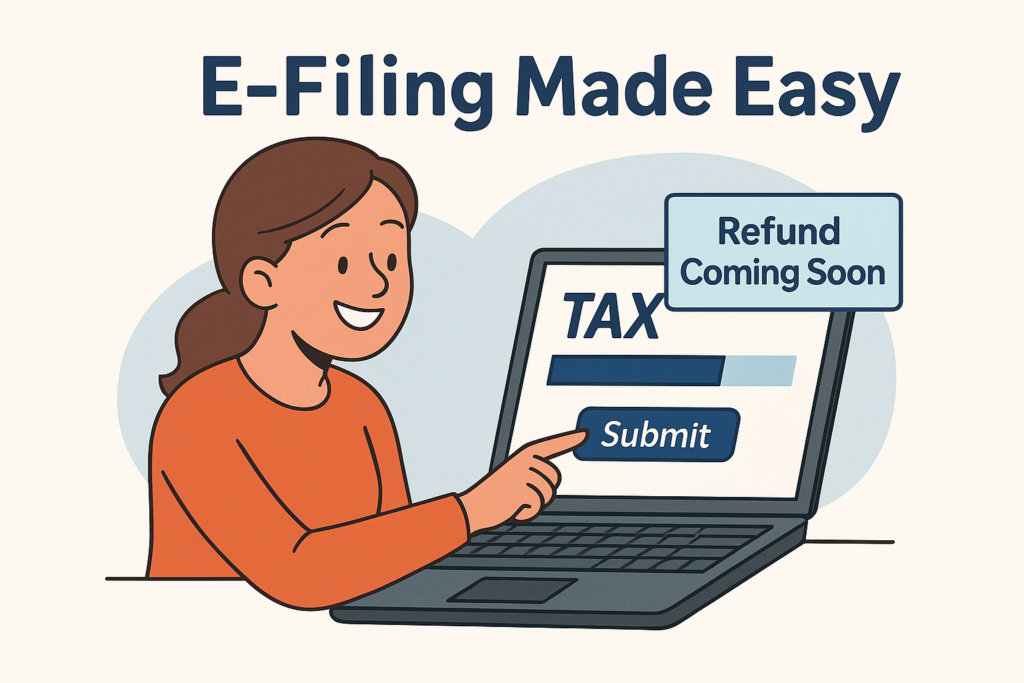Why Tax Filing in 2025 Feels Like a Big Deal
Look, taxes are never exactly fun, but 2025’s got a few new twists that make it worth paying attention. The IRS has been rolling out changes—some tech upgrades, some new forms, and a few tweaks to credits and deductions—that could affect how you file. Plus, after all the economic ups and downs lately, a lot of us are looking to maximize our refunds or at least avoid owing Uncle Sam a chunk of cash. For most Americans, filing taxes is about getting it done right, avoiding stress, and maybe even coming out ahead. 2025 Tax Tips
So, what do regular folks like us need to know? Let’s break it down with tips that hit the stuff we all care about—saving time, saving money, and staying out of trouble with the IRS.

Tip 1: Get Your Paperwork Together Early (Like, Now)
Okay, picture this: it’s mid-April, and you’re frantically digging through a shoebox of receipts, trying to find that one W-2 you swear you saw last month. Sound familiar? We’ve all been there. The number one thing you can do to make tax season smoother is to start organizing your documents early. January’s when most of your tax forms—like W-2s, 1099s, and 1098s—start showing up in your mailbox or inbox, so set up a folder (physical or digital) to keep everything in one place.
Here’s what you’ll likely need:
- W-2s from your employer if you’re on a payroll.
- 1099s if you’re a freelancer, gig worker, or got income from other sources like investments or side hustles.
- 1098s for mortgage interest or student loan interest—big ones for deductions.
- Receipts for charitable donations, medical expenses, or business costs if you’re self-employed.
- Form 1095-A if you got health insurance through the Marketplace.
Pro tip: If you’re expecting a 1099-K because you sold stuff online or got paid through apps like Venmo or PayPal for goods and services (over $5,000 in 2024), make sure you’ve got records to back up what’s taxable and what’s not. A lot of people get tripped up here, thinking every payment is taxable, but personal transactions (like splitting dinner) usually aren’t.
Why does this matter? Getting organized early cuts down on stress and helps you spot any missing forms before the April 15 deadline sneaks up. Plus, if you’re missing something, you’ve got time to track it down without pulling your hair out.
Tip 2: Know If You Even Need to File
Not everyone has to file a tax return, but most of us do. If you’re wondering whether you’re on the hook, it usually comes down to how much you earned in 2024. For 2025, the IRS sets income thresholds based on your filing status and age. For example:
- Single filers under 65 need to file if their gross income was at least $14,600.
- Married filing jointly under 65? It’s $29,200 combined.
- Head of household? That’s $21,900.
If you’re over 65, those numbers go up a bit because of an extra standard deduction. Also, if you’re self-employed and made at least $400 in net earnings, you’ve gotta file, no matter how low your total income is.
Here’s a common question: “I barely made any money last year—do I still have to file?” Sometimes, even if you don’t have to, it’s worth it. Why? You might be eligible for refundable credits like the Earned Income Tax Credit (EITC) or Child Tax Credit (CTC), which can put money back in your pocket. So, don’t skip filing just because you think your income’s too low—check first!

Tip 3: E-File for Speed and Accuracy
Listen, nobody loves filling out forms, but in 2025, e-filing is the way to go. It’s faster, more secure, and way less likely to have errors than paper filing. Most folks who e-file and choose direct deposit get their refunds in under 21 days—sometimes as quick as a week or two. Paper returns? You’re looking at six weeks or more, and that’s if everything’s perfect.
The IRS has been pushing hard to make e-filing easier with tools like IRS Free File (for folks with incomes under $84,000) and Direct File, which is now available in 24 states and covers more tax situations than last year. Direct File’s a game-changer if you’ve got a straightforward return—it’s free, web-based, and walks you through step-by-step. Plus, it’s got live chat support in English and Spanish if you get stuck.
Even if your taxes are a bit more complicated, software like TurboTax or H&R Block can guide you through e-filing and catch mistakes you might miss on paper. And here’s a little local wisdom: if you’re in a rush for that refund to cover bills or maybe treat yourself to something nice, e-filing with direct deposit is your best bet. Just double-check your bank account and routing numbers—nothing’s worse than a refund going to the wrong account!
Tip 4: Don’t Sleep on Deductions and Credits
Alright, let’s talk about everyone’s favorite part: saving money. Deductions and credits are your best friends when it comes to lowering your tax bill or boosting your refund. The trick is knowing what’s out there and what you qualify for.
Deductions
Deductions reduce your taxable income, which means you’re taxed on less of what you earned. In 2025, the standard deduction is:
- $14,600 for single filers or married filing separately.
- $29,200 for married filing jointly or qualifying surviving spouse.
- $21,900 for head of household.
Most folks take the standard deduction because it’s simpler, but if you’ve got a lot of expenses—like mortgage interest, medical costs (over 7.5% of your income), or charitable donations—it might be worth itemizing. For example, if you donated $5,000 to your local food bank or church, that could add up fast if you’ve got other deductible expenses.
Self-employed folks, listen up: you can deduct stuff like home office expenses, business travel, or even half of your self-employment tax. Keep good records, though—receipts are your lifeline if the IRS comes knocking.
Credits
Credits are even better than deductions because they directly cut your tax bill dollar-for-dollar. Some big ones for 2024 taxes include:
- Child Tax Credit (CTC): Up to $2,000 per kid under 17, with part of it refundable if you don’t owe enough taxes. If Congress tweaks this later, the IRS says they’ll adjust returns automatically, so don’t wait to file.
- Earned Income Tax Credit (EITC): This one’s a lifesaver for low- to moderate-income workers, especially if you’ve got kids. It can be worth thousands, and it’s refundable.
- Education Credits: The American Opportunity Credit (up to $2,500) and Lifetime Learning Credit (up to $2,000) can help if you or your kids are in school.
Here’s the deal: credits and deductions can get complicated, so take your time to read up or use tax software that asks you plain-English questions to figure out what you’re eligible for. Missing out on these is like leaving money on the table at a buffet—nobody wants that!

Tip 5: Watch Out for Digital Assets (Crypto, Anyone?)
If you’ve been dabbling in crypto, NFTs, or other digital assets, heads up: the IRS is watching closer than ever. When you file your 2024 taxes, you’ll have to answer a yes-or-no question on your Form 1040 about whether you sold, exchanged, or disposed of any digital assets. If you did, you need to report that income, whether it’s from trading Bitcoin or cashing out an NFT.
A lot of folks get nervous about this, thinking the IRS is gonna audit them just for owning crypto. Relax—it’s not about owning; it’s about transactions. If you sold crypto for a profit, that’s taxable as a capital gain. If you got paid in crypto for a gig, that’s income. Keep track of your cost basis (what you paid) and the sale price to figure out your gain or loss. Apps like CoinTracker or Koinly can help, but even a simple spreadsheet works if you’re old-school.
Why’s this a big deal? The IRS has been cracking down on unreported crypto income, and nobody wants a surprise audit letter. Be upfront, report what you owe, and you’ll sleep better at night.
Tip 6: Side Hustles and Gig Work—Report It All
Raise your hand if you’ve got a side hustle—Uber, Etsy, DoorDash, freelancing, you name it. Yeah, a lot of us do! Gig work’s awesome for extra cash, but it comes with tax responsibilities. If you earned over $600 from a platform, you’ll get a 1099-NEC or 1099-K, and you’ve gotta report that income, even if it’s less than $600.
Here’s where it gets real: taxes on side hustle income can sneak up on you, especially if you’re not setting aside money for it. Unlike a regular job where taxes are withheld, gig income usually comes to you raw. A good rule of thumb is to set aside 25-30% of your gig earnings for taxes. If you expect to owe $1,000 or more when you file, you might need to make quarterly estimated tax payments—due January 15, April 15, June 15, and September 15.
On the flip side, gig workers can deduct a ton of expenses—think mileage if you drive for Lyft, supplies for your Etsy shop, or even a portion of your phone bill if you use it for work. Track those expenses like a hawk, and you’ll thank yourself when tax time rolls around.
Tip 7: Don’t Fall for Scams
Tax season brings out the worst in some people—scammers, that is. Every year, folks get hit with fake IRS calls, phishing emails, or sketchy “tax preparers” promising huge refunds. Here’s how to stay safe:
- The IRS never calls you out of the blue demanding payment or threatening jail time. If you get a call like that, hang up.
- Don’t click links in emails claiming to be from the IRS. Always go directly to IRS.gov for legit info.
- If you’re hiring a tax pro, check their credentials. Look for a CPA, Enrolled Agent, or someone with a Preparer Tax Identification Number (PTIN). Steer clear of anyone who says they can get you a refund without seeing your records.
Scammers love to prey on our stress, so keep your guard up. If something feels off, trust your gut—it’s usually right.

Tip 8: Plan for Your Refund (or What You Owe)
Let’s talk about the fun part: refunds. If you’re expecting one, think about how you’ll use it before it hits your account. Paying off high-interest debt, boosting your emergency fund, or even investing in a Roth IRA are all solid moves. But hey, treating yourself to a little something—like a weekend getaway or that new grill you’ve been eyeing—is okay too, as long as you’re not blowing it all.
What if you owe money? Don’t panic. The IRS offers payment plans if you can’t pay in full by April 15. You can apply online at IRS.gov, and as long as you’re upfront and make payments on time, they’re pretty flexible. Just don’t ignore the bill—penalties and interest add up fast.
Tip 9: Use Free Resources If You’re on a Budget
Taxes don’t have to break the bank. If your income’s under $67,000, check out Volunteer Income Tax Assistance (VITA) programs—they offer free tax prep in person or virtually. Military folks and veterans can use MilTax for free filing. And don’t forget IRS Free File or Direct File for DIY options if you’re comfortable with tech.
Even if you don’t qualify for free prep, the IRS website’s got a ton of resources, like the Interactive Tax Assistant, which answers common questions based on your situation. It’s like having a tax nerd friend who’s always available.
Tip 10: Start Planning for Next Year
Once your 2024 taxes are done, don’t just shove it all in a drawer and forget about it. Use this year’s return to plan for 2025. Did you owe a ton? Maybe adjust your W-4 with your employer to withhold more from your paycheck. Got a huge refund? That’s nice, but it also means you’re giving the IRS an interest-free loan all year—tweak your withholding to keep more in your pocket monthly.
If you’re self-employed or have a side hustle, start tracking expenses and income now for 2025. Apps like QuickBooks or even a simple Google Sheet can make it painless. And if you’ve had big life changes—got married, had a kid, bought a house—those can affect next year’s taxes, so keep that in mind.

Wrapping It Up: You’ve Got This!
Tax season doesn’t have to be a nightmare. With a little prep, some smart choices, and maybe a cup of coffee to keep you going, you can tackle your 2024 taxes like a pro. The key is starting early, staying organized, and not being afraid to use the tools and resources out there. Whether you’re e-filing for a quick refund or itemizing deductions to save big, you’re in control.
We hope this guide feels like a chat with a friend who’s got your back—not some stuffy tax manual. Taxes are a part of life, but they don’t have to run your life. So, grab those forms, fire up your laptop, and let’s get this done. You’ll be sipping lemonade by April 15, knowing you nailed it.
When is the deadline to file my 2024 taxes in 2025?
The big day is April 15, 2025, for most folks. If you need more time, you can file for an extension using Form 4868, which gives you until October 15, 2025. But heads up—an extension to file doesn’t mean an extension to pay. If you owe, you need to estimate and pay by April 15 to avoid penalties.
How long will it take to get my refund?
If you e-file and choose direct deposit, most refunds land in under 21 days—sometimes as quick as 10 days. Paper returns take way longer, like 6-8 weeks. If you claimed the EITC or Additional Child Tax Credit, expect a slight delay, usually until mid-February at the earliest.
I got a 1099-K from PayPal. Do I owe taxes on everything?
Not necessarily. A 1099-K reports payments for goods and services, but personal transactions—like friends paying you back for dinner—aren’t taxable. You’ll need to figure out which payments are taxable income (like selling stuff online) and report only those. Keep good records to back it up!
Can I file for free?
Yup, if your income’s under $84,000, IRS Free File’s a great option. Direct File’s also free in 24 states for simpler returns. VITA programs offer free prep for incomes under $67,000, and MilTax is free for military folks. Check IRS.gov for details.
I forgot a form or made a mistake. What now?
No sweat—file an amended return using Form 1040-X. You can do it electronically for recent years, which is faster. Just include the corrected info and explain what changed. If you owe more, pay as soon as you can to limit penalties and interest.
Should I hire a tax pro or do it myself?
Depends on your situation. If your taxes are simple—just a W-2 and maybe a couple deductions—DIY with software or Direct File works fine. If you’ve got a business, rental properties, or crypto, a CPA or Enrolled Agent can save you headaches and maybe even money by spotting deductions you’d miss.
What’s the deal with the Child Tax Credit for 2024?
For 2024, it’s up to $2,000 per kid under 17, with up to $1,600 refundable. If Congress changes it later, the IRS will adjust returns automatically, so file when you’re ready. You’ll need your kid’s Social Security number and proof they lived with you most of the year.
I sold some crypto last year. How do I report it?
Report any gains or losses on Form 8949 and Schedule D. Track what you paid (your cost basis) and what you sold it for. If you got crypto as payment for work, that’s income reported on Schedule C or as miscellaneous income. The IRS asks about digital assets on your 1040, so answer honestly.